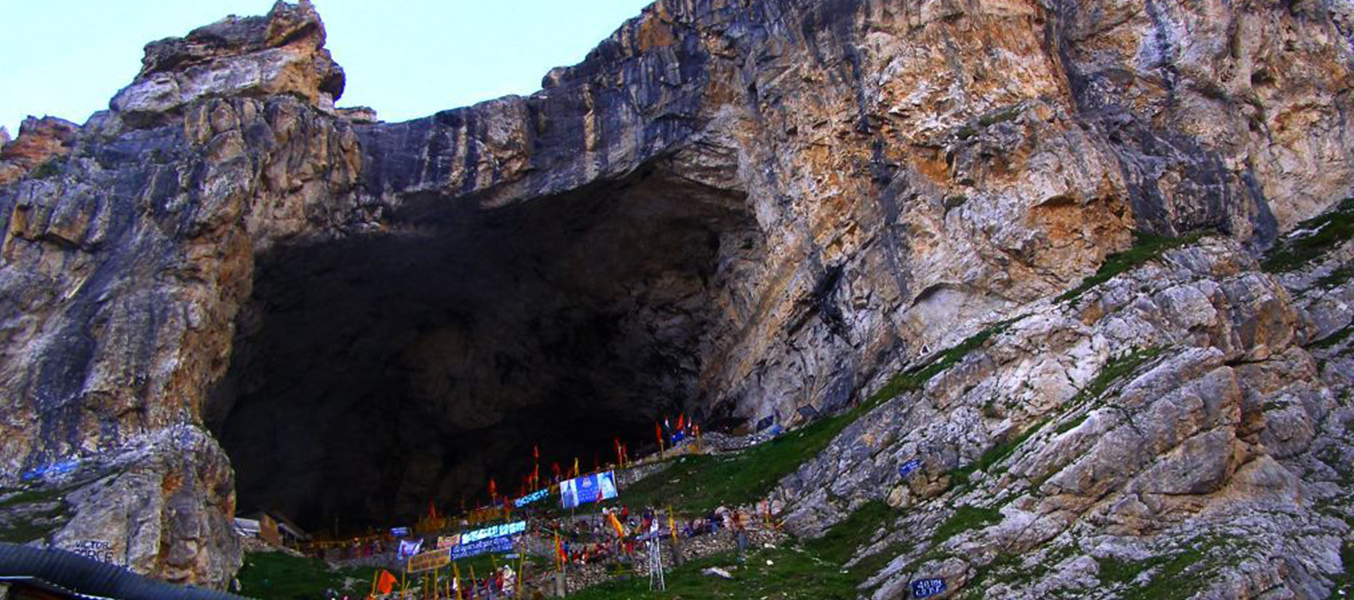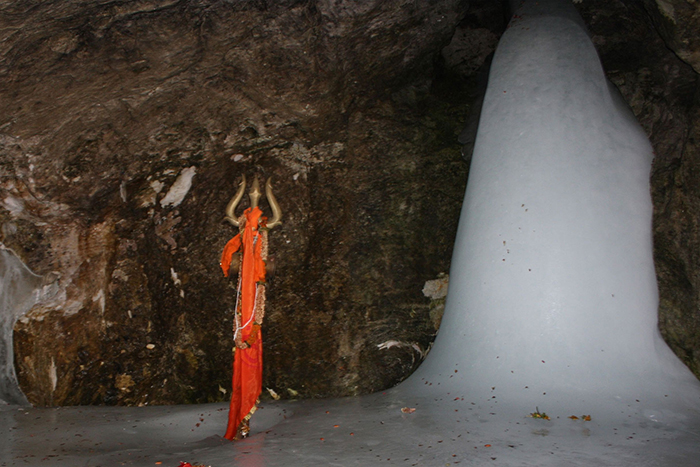

Amarnath cave is a Hindu shrine located in Jammu and Kashmir. The cave is situated at an altitude of 3,888 m (12,756 ft.), about 141 km (88 mi) from Srinagar, the summer capital of Jammu and Kashmir and reached through Pahalgam town. The shrine forms an important part of Hinduism, and is considered to be one of the holiest shrines in Hinduism. The cave is surrounded by snowy mountains. The cave itself is covered with snow most of the year except for a short period of time in summer when it is open for pilgrims. Hundreds of thousands of Hindu devotees make an annual pilgrimage to the Amarnath cave across challenging mountainous terrain.
Inside the 40 m (130 ft.) high Amarnath cave, a stalagmite is formed due to freezing of water drops that fall from the roof of the cave on to the floor and grows up vertically from the cave floor. It is considered to be a Shiva Linga by Hindus. It is mentioned in the ancient Hindu texts of Mahabharata and Puranas that Lingam represents Lord Shiva. The Lingam waxes during May to August, as snow melts in the Himalayas above the cave and the resultant water seeps into the rocks that form the cave and gradually wanes thereafter. As per religious beliefs, it has been claimed that the lingam grows and shrinks with the phases of the moon reaching its height during the summer festival, although there is no scientific evidence for this belief.
According to a Hindu legend, this is the cave where Shiva explained the secret of life and eternity to his divine consort, Parvati.
It is believed that Lord Shiva left Nandi, the bull, at Pahalgam (Bail Gaon). At Chandanwari, he released the Moon from his hair (Jata). On the banks of Lake Sheshnag, he released his snakes. At Mahagunas Parvat (Mahaganesh Mountain), he left his son Lord Ganesha. At Panjtarni, Lord Shiva left behind the five elements - Earth, Water, Air, Fire and Sky. As a symbol of sacrificing the earthly world, Lord Shiva performed the Tandava Dance. Then, finally, Lord Shiva entered the Holy Amarnath Cave along with Mata Parvati.
Today, Amarnathji Yatra is an essential part of the Hindu pilgrimage and though the route is difficult to negotiate, it is equally exciting. Every year, thousands of devotees come to pay homage before Shiva in one of his famous Himalayan abodes.
Lord Shiva - The Creator, Preserver and the Destructor of this universe. The Lord's attributes represent his victory over the demonic activity, and calmness of human nature. Amarnathji Yatra embodies this spirit of adventure and helps human being to attain the ultimate level of spirituality.
Unknown to them, a pair of mating pigeons eavesdropped on this conversation and having learned the secret, are reborn again and again, and have made the cave their eternal abode. Many pilgrims report seeing the pigeons-pair when they trek the arduous route to pay obeisance before the ice-lingam (the phallic symbol of Shiva).
The trek to Amarnathji, in the month of Shravan (July - August) has the devout flock to this incredible shrine, where the image of Shiva, in the form of a lingam, is formed naturally of an ice - stalagmite, and which waxes and wanes with the moon. By its side are, fascinatingly, two more ice - lingams, that of Parvati and of their son, Ganesha.
Devotees travel on foot, either from Srinagar or from Pahalgam. “The latter journey takes approximately 5 days". The State Road Transport Corporation and Private Transport Operators provide the regular services from Jammu to Pahalgam and Baltal. Also privately hired taxis are available from Jammu & Kashmir. The shorter northern route is just about 16 km long, but has a very steep gradient and is quite difficult to climb. It starts from Baltal and passes through Domel, Barari, and Sangam to reach the cave. The northern route is along the Amarnath valley and all along the route one can see the river Amaravati (a tributary of Chenab) which originates from Amarnath Glacier. Helicopter services from base camp to Panjtarni (6 km from the cave) are also available from various private operators. Get in touch with our travel counsellors for further route information.